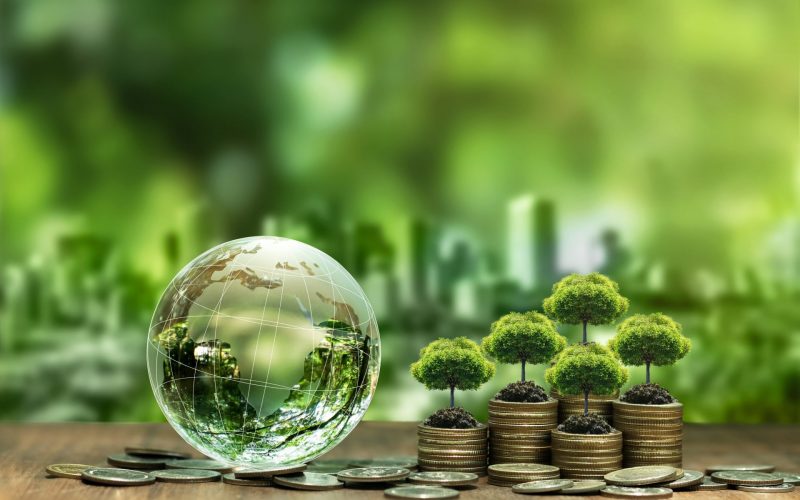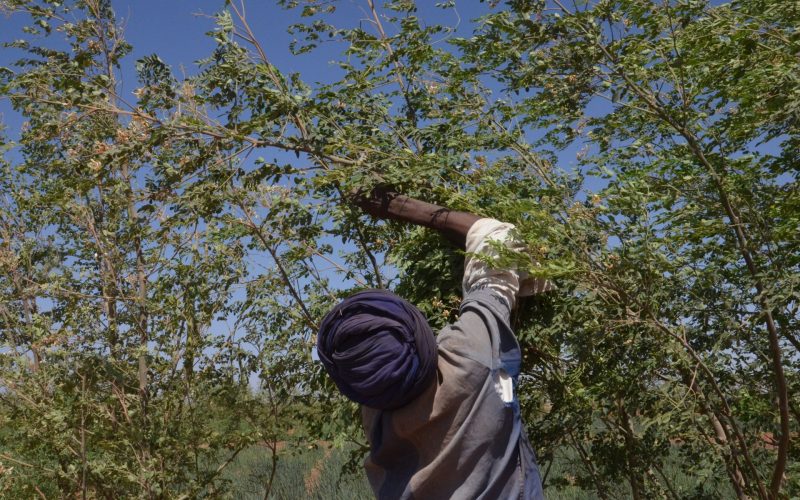Recommendations
Co-benefits between country responses to the COVID-19 pandemic and the climate crisis should be explored and implemented. This can entail:
- Financing human health system capacities and social protection instruments in low-and-middle income countries;
- Tax and subsidy reforms to remove, for example, fossil fuel subsidies and incentivise low carbon growth;
- Targeted stimulus packages within certain sectors such as renewable energy;
- Public works programmes on infrastructure development with dual climate benefits; and
- GHG emission reduction conditions embedded within state bailouts or other state relief.
Executive summary
In many senses the COVID-19 pandemic is a climate change parable, with similarities and consequent lessons to be drawn from our responses to each. In this analysis, we argue that while there are understandable competing fiscal and social constraints placed on national governments to urgently respond to the pandemic, there many COVID-19 responses that will have significant and long-lasting climate change benefits. To date, many countries have shown a mixed appetite to tie COVID-19 responses to climate objectives. Some have updated or are in the process of updating their mitigation ambition within NDCs and have tied stimulus measures to activities that reduce greenhouse gas (GHG) emissions, while others have evidenced a more equivocal or industry protectionist response. Countries that do manage to achieve such dual objectives will be well placed to ratchet up their climate ambition as required by the Paris Agreement in 2020, and will help sustain the delicate political momentum fostered in the climate negotiations since 2015.
Introduction
COP 26 to the UNFCCC was scheduled to take place in Glasgow, Scotland, in November 2020, but has been postponed to a future date in 2021 as a result of the COVID-19 international health crisis. In many senses the COVID-19 pandemic is a climate parable, with cause-and-effect similarities requiring parallel, if not completely congruent, responses. For example, both represent extreme shocks to overarching physical systems (climate and health), and both are accompanied by acutely negative economic consequences requiring resolution through mitigation action directed at their underlying causes. In this analysis, we explore these parallels and what actions taken, to date, either undermine or benefit from this alignment. We conclude by making recommendations on how the COVID-19 response could bolster the political success of COP 26 and, ultimately, longer-term global climate action.
Climate change and COVID-19: a manyheaded hydra
Success or failure in concerted human endeavours usually boils down to politics and by exacerbating existing risks, exploiting anthropogenic and natural feedback-loops, and primarily impacting highly vulnerable targets, both COVID-19 and climate change are risk-multipliers requiring coherent, risk-averse and resilient governance and management strategies. This means that efforts to deal with COVID-19 may have concomitant benefits for global climate action. The pandemic gives us a terrifying foretaste of the effects of a fully-fledged climate crisis with simultaneous exogenous shocks to, and disruption of, supply chains and sources of industrial and commercial demand, and global transmission and amplification mechanisms.1Dickon Pinner, Matt Rogers and Hamid Samandari, ‘Addressing Climate Change in a Post Pandemic World,’ McKinsey Quarterly, April 7, 2020.COVID-19 and climate change are both systemic, with worldwide and rapidly accelerating consequences requiring fast-tracked yet scientifically sound solutions. It is acknowledged, for example, that healthcare systems are particularly vulnerable to climate impacts 2As a result of as the prevalence and distribution of food and vector borne diseases such as malaria, and the exacerbation of existing vulnerabilities to tuberculosis and HIV, heat stress. See Chersich et al., ‘Impacts of Climate Change on Health and Well-being in South Africa,’ International Journal of Environmental Research and Public Health 15, no. 9, (2018): 1884, who found that ‘climate change in South Africa could be reframed as predominately a health issue, one necessitating an urgent health-sector response.’and, as a result, COVID-19-driven strengthening of such systems will have knock-on climate-positive implications, including GHG mitigation and adaptive co-benefits.3Mitigation refers to the reduction of GHG and adaption refers to processes aimed at adapting and/or shifting natural and non-natural systems to respond to the anticipated impacts of climate change. Co-benefits are those that arise as a consequence of mitigation and/or adaptation actions and such actions can be regarded as two sides of the same coin. For example, Chersich et al., ‘Impacts of Climate Change on Health and Well-being in South Africa,’ identify the future negative health impacts of increasing heat-levels in the South African domestic environment, focusing on the typical footprint of the poorly insulated low-cost/government-built housing and informal settlements which are poorly insulated against heat and cold; and replacing these with higher-quality and better-insulated structures to have marked positive health consequences. While the latter may be regarded as climate-related adaptation, constructing better domestic dwellings can also have mitigation co-benefits. In a uniquely South African example, the Kuyasa Clean Development Mechanism mitigation project achieves measurable GHG emissions reductions by installing solar water heaters, insulated ceilings and energy efficient light bulbs. Kuyasa also improves in-door air quality that curtails the incidence of pulmonary pneumonia and carbon monoxide poisoning. See ‘Projects,’ Pace, https://www.carbon.org.za/credible_carbon_projects/kuyasa.htm. Adaptation co-benefits of improving health-care include more resilient systems and, potentially, improvements to disaster response mechanisms and systems or at least awareness of the need for such improvements, particularly in relation to immediate short-term relief to vulnerable groups.On the other hand, both crises require the deployment of vast financial and other resources and care will need to be exercised to avoid undermining climate change actions ,by redirecting climate funds to financing COVID-19 measures. While funding both climate and COVID-19 responses is essential, with neither taking precedence, there are also potential synergies for governance impelled by recognition of the COVID-19/climate nexus.
Paris and the long-term temperature goal
The all-consuming immediacy of the COVID-19 pandemic makes it is easy to forget the international build-up to COP 26 and its delay is particularly unfortunate because of the disappointing outcome of COP 25 (Madrid, December 2019). COP 25’s equivocation underscored the extreme urgency of progressing the global climate change agenda and COP 26 had been hailed as a ‘super summit’ that would finally crystalise medium- and long-term international action. Most significantly, COP 26 was to herald the 2020 deadline for updating individual and cumulative mitigation ambition of the NDCs under the Paris Agreement. The postponement of COP 26 comes at a critical time for climate governance, and its postponement has prompted the very real likelihood of delays to the global response.4The Paris Agreement (UNFCCC, Decision 1/CP.21), was the formal outcome of COP 21 (Paris, December 2015) – see: https://unfccc.int/ files/essential_background/convention/application/pdf/english_paris_agreement.pdf. An NDC is the statement of ambition, by a country Party to the Paris Agreement, to take domestic climate change action. In addition to NDC updates, COP 26 also triggers a series of other actions, including the determination of NDC-compliance indicators and the elaboration of remedial actions for noncompliances.
The climate-positive potential of cumulative global ambition is assessed according to whether total mitigation outcomes, across all NDCs, are sufficient to achieve the Paris Agreement’s long-term temperature goal. The goal is expressed as: seeking to limit the average global temperate increase to well-below 2°C,5Above pre-industrial levels.and pursuing efforts to limit such increase to 1.5°C, by peaking global GHG emissions as soon as possible to achieve net zero GHG emissions6Expressed as a balance between anthropogenic emissions by sources and removals by sinks of greenhouse gases.by 2050. Achieving the temperature goal, within the required timeframe, will necessitate significant and incremental near- to medium-term mitigation action, most urgently during the course of this decade. For example, the 1.5°C objective requires emissions reductions of more than 7.6% year-on-year during the 2020s to reach 45% below 2010 levels by 2030.7UN Environment Programme, Emissions Gap Report, (Nairobi: UNEP, 2019).Presently, however, there is a significant emissions gap between what countries have pledged to mitigate in their NDCs and what is required by science.8UN Environment Programme, Emissions Gap Report. At present, if all unconditional mitigation contributions in the initial NDCs were implemented there would still be an emissions gap in 2030 of 15 gigatonnes to achieve a 2°C future, and 32 gigatonnes to achieve a 1.5°C future.Even before COVID-19, the cumulative level of mitigation ambition, pledged within NDCs, put the world on a trajectory for an increase of up to 3.2°C.9UN Environment Programme, Emissions Gap Report.
Initially encouraging estimates show the COVID-19-driven economic downturn having caused a decrease in global emissions of approximately 2000 Mt/CO2e10Million tonnes of Carbon Dioxide Equivalent.to date for 2020, as compared to 2019. This equates to a 5.5% year-on-year reduction11Simon Evans, ‘Analysis: Coronavirus set to cause largest ever annual fall in CO2 emissions,’ Carbon Brief April 9, 2020, https://www.carbonbrief.org/analysiscoronavirus-set-to-cause-largest-ever-annual-fall-in-co2-emissions.with projections estimating that this may be as much as 8% this year.12International Energy Agency, Global Energy Review 2020, April 2020, https://www.iea.org/reports/global-energy-review-2020/ global-energy-and-co2-emissions-in-2020.This would represent the largest-ever reduction, and more than six times the decrease precipitated by the 2009 financial crisis.13International Energy Agency, Global Energy Review 2020It is essential to understand, however, that these curtailments are only temporary. Science requires a year-on-year sustained reduction to achieve the 1.5°C objective and not a once-off event. In this regard the International Monetary Fund has speculated that, notwithstanding a severely negative economic outlook for 2020, growth may rebound sharply in 2021, with global GDP likely rising to 5.8% which would, in-turn, likely mean a sharply correlated increase in GHG emissions.14International Monetary Fund, World Economic Outlook, April 2020: The Great Lockdown, April 2020, https://www.imf.org/en/ Publications/WEO/Issues/2020/04/14/weo-april-2020.Consequently, any argument that uses pandemic-related GHG emissions reductions as the basis for arguing that COVID-19 will automatically accelerate a climate-friendly decoupling of the linkage between GHG emissions and economic outputs, is misplaced. In order to sustain any COVID-driven climate mitigation gains, post-pandemic political governance must be deliberately aligned with an economically and socially just transition to a climate-resilient future.15See: Climate change and the just transition – A guide for investor action Grantham Research Institute on Climate Change and the Environment (2018), at: http://www.lse.ac.uk/granthaminstitute/wp-content/uploads/2018/12/Climate-change-and-the-justtransition_Guide-for-investor-action.pdf.
In this context, the need to increase NDC mitigation ambition assumes an elevated importance that will require unprecedented levels of political will. It is possible, for example, that when COP 26 is finally called-to-order, country Parties may seek to rely on the significant financial expenditure incurred to fight the pandemic as a basis to weaken their NDC commitments, and delay negotiations on increasing mitigation ambition. The UNFCCC is leading by example in this regard, with the online June Momentum for Climate Change initiative continuing the work of the Convention’s scientific bodies but, of necessity, falling-short of formal negotiations.16Earth Negotiations Bulletin, Momentum for Climate Change Briefing Note, June 12, 2020, http://enb.iisd.org/climate/junemomentum/. The initiative did not constitute a formal opportunity to progress the multi-lateral negotiations.
As this analysis suggests, the spectre of pandemic-drive financial constraints need not impede the implementation of climate responses, as there are multiple opportunities to dovetail national COVID-19 measures with domestic climate objectives. Doing so will sustain diplomatic momentum in the climate negotiations, towards a rescheduled COP 26 and, potentially, avert the failure of the most critical COP of the 2020s.
Global action in response to the pandemic
A number of country Parties have acknowledged the urgency of achieving the Paris temperature goal and for more concerted climate action. It has been argued, for example, that the pandemic presents South Africa with an opportunity for simultaneous postCOVID-19 recovery and green economy transition.17Henk Sa, ‘A greener, more resilient and just recovery for South Africa, post COVID-19,’ BizCommunity, June 25, 2020, https://www.bizcommunity.com/Article/196/702/205503.html. The national government defines green economy as a ‘system of economic activities related to the production, distribution and consumption of goods and services that result in improved human well-being over the long term, while not exposing future generations to significant environmental risks or ecological scarcities’.18Department of Environment, Forestry and Fisheries, ‘About Green Economy,’ https://www.environment.gov.za/projectsprogram mes/greeneconomy/about.The definition anticipates policy reform support for green investment that delinks resource-use/environmental impacts from economic growth, and interventions implemented according to this formulation would have real potential to sustain COVIDdriven climate mitigation gains.
In a wider African context, Rwanda has expressed a desire to increase ambition and its revised NDC anticipates achieving a 38% GHG emission reduction by 2030 through the deployment of renewable energy, vehicle emissions standards and electric vehicles.19Under its previous NDC the country had no mitigation target.Other countries are devising economic stimulus packages that have climate co-benefits, such as the Canadian federal government’s CAD 20Three letter currency code for Canadian dollar.750 million fund which targets oil and gas emissions, and the further CAD 1.7 billion for the rehabilitation of orphaned and inactive wells.21Paula Olexiuk and Carson Wetter, ‘Fighting on two fronts: Arrival of Canadian energy sector relief,’ Osler, April 21, 2020, https://www.osler.com/en/resources/regulations/2020/fighting-on-two-fronts-arrival-of-canadian-energy-sector-relief.Interest in renewable energy has also escalated since the onset of the pandemic, with various countries, including India and the UK, prioritising renewables over coal-based electricity generation during the crisis, mostly as a result of the falling relative costs of these technologies.22Jonathan Watts and Jillian Ambrose, ‘Coal industry will never recover after coronavirus pandemic, say experts,’ The Guardian, May 17, 2020, https://www.theguardian.com/environment/2020/may/17/coal-industry-will-never-recover-after-coronavirus-pandem ic-say-experts.
Elsewhere, however, positive signals are diluted with the negative. For example, while the EU is seeking to revise the bloc’s mitigation target by September 2020,23European Commission, ‘Frans Timmermans’ opening remarks at the St. Petersburg Climate Dialogue,’ April 28, 2020, https://ec.europa.eu/commission/presscorner/detail/en/statement_20_770.and the majority of member states have agreed to a COVID-19 response that is aligned with the region’s new Green Deal,24Joint Statement of the Members of the European Council, March 26, 2020, https://www.consilium.europa.eu/media/43076/26-vceuco-statement-en.pdf and ‘Germany, France throw weight behind EU’s ‘green’ recovery plan,’ Reuters, May 19, 2020, see: https://uk.reuters.com/article/uk-eu-recovery-climate/germany-france-throw-weight-behind-eus-green-recovery-plan-idUKKBN 22V1ZJ.celebrations over the Green Deal have been mired by controversy over suggestions that climate action be contingent on the provision of a COVID-19-related bail out to the aviation sector.25Jennifer Rankin, ‘Link climate pledges to €26bn airline bailout, say Europe’s greens,’ The Guardian, April 30, 2020, https://www. theguardian.com/business/2020/apr/30/link-climate-pledges-to-26bn-airline-bailout-say-europes-greens-environment.Indications are also that China is turning to high emissions industries and investments to stimulate the domestic economy. Some analysts have suggested that increased heavy industrial output and construction over the remainder of 2020, together with a weakened service sector, will raise the amount of CO2 (carbon dioxide) nationally produced per unit of GDP growth.26Muyu Xu and David Stanway, ‘China’s post-pandemic economic stimulus puts 2020 climate pledges at risk,’ Reuters, May 20, 2020, https://www.reuters.com/article/us-health-coronavirus-china-climate-anal/chinas-post-pandemic-economic-stimulus-puts2020-climate-pledges-at-risk-idUSKBN22W0YW.Much will depend on the economic recovery policies that are implemented over the coming weeks and months. Some have speculated that these might, indeed, support a high-tech and service-driven low-carbon transition.27Alexander Koty, ‘Why China’s COVID-19 Stimulus Will Look Different Than in the Past,’ China Briefing, April 6, 2020, https://www.china-briefing.com/news/chinas-stimulus-measures-after-COVID-19-different-from-2008-financial-crisis/, and Evelyn Cheng, ‘Electric cars take the spotlight in China’s post-coronavirus stimulus plans,’ CNBC, May 5, 2020, https://www.cnbc. com/2020/05/04/electric-cars-take-the-spotlight-in-chinas-post-coronavirus-stimulus-plans.html.
Less promising is Australia, where the federal government is motivating for an expansion of coal mines to bolster employment during the pandemic’s economic downturn.28Peter Ker, Jenny Wiggins and Angela Mcdonald-Smith, ‘Coal mining Expansion even More important,’ Financial Review, March 24, 2020, https://www.afr.com/companies/energy/coal-mine-expansion-even-more-important-20200324-p54dcx.Oil and gas exploration and mining licence fees have also been suspended to provide financial relief to these sectors in South Australia.29Government of South Australia, Department for Energy and Mining, Fee Relief for COVID19-hit resources sector, (April 3, 2020), http://energymining.sa.gov.au/minerals/latest_updates/fee_relief_for_covid19-hit_resources_sector.Similarly, notwithstanding recent efforts by multinationals to encourage the coupling of COVID-19 responses to a net-zero emissions future,30‘Over 150 global corporations have urged world leaders for net-zero recovery from COVID-19,’ We Mean Business Coalition, May 19, 2020, https://www.wemeanbusinesscoalition.org/press-release/business-ambition-statement/.there has been an upswing in lobbying by industry for state aid toward support for high emissions sectors. A report by Influence Map depicts high levels of corporate lobbying for immediate relief amidst the chaos, finding that the oil and gas sector is the most active globally in lobbying governments for financial support and deregulation in response to COVID-19.31‘The Climate Crisis and Climate Lobbying: An Influence Map Briefing,’ Influence Map, April 2, 2020, https://influencemap.org/report /The-Coronavirus-Crisis-and-Climate-Lobbying-23249d39450ff19b441090a6a50174eb. The oil and gas industry have also lobbied the Canadian government to freeze the carbon tax and delay new climate change regulations while the industry weathers the COVID-19 storm. See: Mia Rabson, ‘Freeze Carbon Tax, delay new climate regs during virus crisis, oil lobby asks,’ Financial Post, June 3, 2019, https://business.financialpost.com/pmn/business-pmn/freeze-carbon-tax-delay-new-climate-regs-during-virus-crisis-oillobby-asks?utm_source=CP+Daily&utm_campaign=1f2abd44fd-CPdaily17042020&utm_medium=email&utm_term=0_a9d8834f721f2abd44fd-110273845).This strategy has seen some success, eg, the Canadian government’s hesitation at progressing essential regulatory GHG initiatives.32The Canadian Environment Ministry has pushed-back the release of a draft regulation for the national Clean Fuel Standard, although the 2022 start-date for implementation of the programme’s liquid fuel stream, remains intact. See: ‘Canada delays publication of draft Clean Fuel Standard regulation, citing coronavirus,’ Carbon Pulse, April 25, 2020, https://carbonpulse.com/97620/utm_source=CP+Daily&utm_campaign=3f6cd3ef85CPdaily24042020&utm_medium=email&utm_term=0_a9d8834f723f6cd3ef85-110273845.
Conclusion and recommendations
On Earth Day 2020, the UN Secretary-General made a statement describing the global existential threat posed by climate change and setting-out six underlying principles for the post-COVID-19 era, including increasing support for the green economy.33‘Secretary-General’s remarks on International Mother Earth Day,’ April 22, 2020, [author to insert link], see: https://unicmanila.org/ 2020/04/22/un-secretary-generals-remarks-on-international-mother-earth-day-22-april-2020/.The pandemic offers a hiatus for reflecting on the world’s future economic trajectory, drawing on past lessons, exploring potential opportunities for substantive infrastructural and investment reform, and applying recovery funding in a manner that underpins climate-compatible development. Examples of such measures include:
- The financing of human health system capacities and social protection instruments in low-and-middle income countries. This will have longer-term climate change adaptive co-benefits by improving resilience to future shocks including those induced by climate change.
- Stimulus packages that decarbonise the world economy and advance NDC objectives, such as:
- Tax reforms for fossil fuels and tax incentives for renewable energy and emission reduction activities. The recent plummet in the price of oil provides an opportune time to address such reforms.
- Investments and public works programmes which foster job creation and support low income livelihoods with dual climate benefits, such as energy efficiency for buildings, renewable energy, preservation or restoration of natural areas, water treatment and sanitation, or sustainable transport infrastructure.34Pinner, Rogers and Samandari, “Addressing Climate Change in a Post Pandemic World”
- The imposition of climate change targets in conditional state financial relief or bail outs granted to carbon intensive sectors.
- Enhancing climate change ambition in NDCs to support all of the above and aligning domestic policy design, implementation and related financial flows accordingly.
The coming months present a particularly important moment to implement such measures, as governments are presently considering and implementing stimulus packages that will dwarf prior public finance pledges to the Green Climate Fund.35See the status of pledges at the Green Climate Fund available at: https://www.greenclimate.fund/document/status-pledges-allcycles.Not doing so risks derailing the significant political milestones achieved since the conclusion of the Paris Agreement, and invites even greater precariousness to the global climate response and consequential financial risk to the global economy.
Acknowledgement
SAIIA gratefully acknowledges the support of the Swedish International Development Cooperation Agency (SIDA) for this publication.







